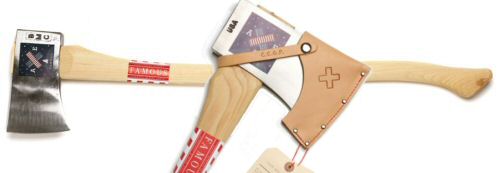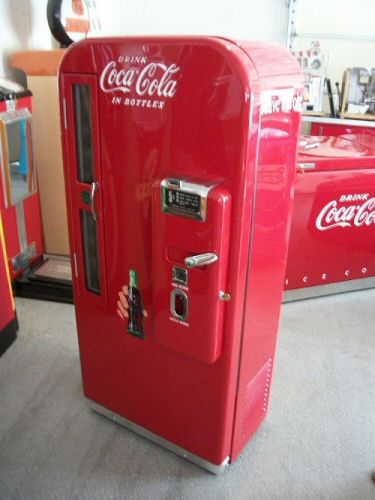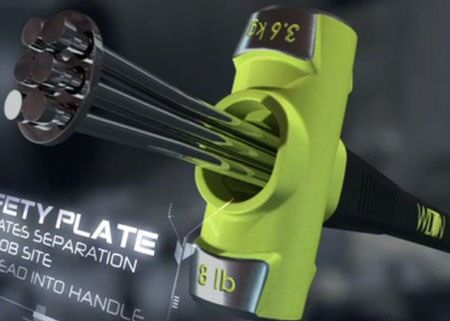
Since receiving an invitation last Tuesday, I’ve really been enjoying Gentlemint. My most recent find in the mint is the Best Made Company out of New York. I’m diggin’ Best Made’s axes, which come in a few different handle colors and finishes. So far, my favorite is this Unfinished American Felling Axe (pictured below). According to Best Made’s about page, the company was founded in 2009 by Peter Buchanan-Smith, a man with a passion for building a better axe. We can’t be the judge of whether the axe truly is better, but we can tell you it looks better than most others we’ve used.

That is one intimidating tool. I’d love to have it handy when the next ne’er-do-well tries to break into the workshop (not that that’s ever happened… but if it did, and I had this axe, well… you know). I especially like the bold USA branding on the handle.
At $158, the axe is definitely pricey. (Best Made says they’re “made for the discriminating consumer, priced and fabricated to compete with the best”). With its nice looking finish, I’d have a tough time bringing myself to actually use it on anything (except the aforementioned ne’er-do-well). Moreso, I’d just like to mount in up on the left side of our pegboard as a permanent fixture. This axe screams American pride, and I’m a sucker for just about any kind of Americana.
(Speaking of Americana, I’m also love this 50s-era restored coke machine that dispenses beer bottles; it’s something I’d love to have in the basement one day… That is, whenever we get back to that project and have $8,000 to spare. I caught wind of this beauty on an episode of Pawn Stars that featured Rick’s Restorations out in Las Vegas. Rick’s got a great site if you’re into restored Americana.)

But I digress.
Best Made’s American Felling Ax does remind me that we have this bad boy, courtesy of Wilton Tools, sitting in the workshop right now.


Technically it’s called the Model 20003 14-lb. Unbreakable Double Faced BASH Sledge Hammer, but I just call it The Punisher. We haven’t had a lot of demolition-related work around either OPC house lately, so I picked up a stone landscaping block just to give this sledge a try. Ethan’s likely going to hand this over to one of our contractors on an upcoming Pro Follow, but unfortunately right now we’ve got only two projects on the slate (a deck build, and a basement finish), neither of which sound like Punisher-employing jobs.
The nice folks at Wilton sent us the BASH a few months back, so we felt the need to get the word out on it. It’s got a steel-reinforced fiberglass shaft with a 6.5 KG (14 lb.) business end. This is a very heavy sledge hammer, but it’s not the biggest Wilton manufactures. They also have this 20lb. model. If we ever get one of those, I’m going to have to come up with an even more intimidating name.
Here’s me taking on the landscaping block with the BASH.
Unless you’re in tip top upper body shape, the BASH will wear you out very quickly. We do appreciate that Wilton has minimized vibration in the handle, and that the grip feels really solid. We also appreciate that Wilton makes lighter versions (an 8lb. and a 2.5lb. model are available–the smallest has a shorter handle).
Here’s a great picture from Wilton’s marketing brochure of the handle reinforcement design that allows them to offer a lifetime guarantee covering handle breakage. And in case you’re wondering: Yes, it does make the handle heavy. The total weight for this model is 17.4 lbs. according to our scale.

The 14 lb. BASH retails for $82 at Amazon. The heavier model goes for $96. That’s a bit pricey for a sledge hammer, but we do appreciate that both Wilton models come with the warranty, meaning they’re the last sledge hammers you should ever have to buy.
….
So, if I can talk Best Made into sending us one of those Felling Axes, maybe we can put it on the left side of the pegboard and put the BASH on the right. Just tell Best Made in the comments section that if they send us one of those axes, you all will be really inclined to buy one. (j/k… but more seriously, we may end up asking for one for the Rewards Center, which is a little thin right now).
A Quick Pro Follow Schedule Update
I hope you all enjoyed reading the finished How to Build a Shed article last week. I know I got a lot out of it. That hip roof was great! Tomorrow, Ethan’s going to give us Day 1 of a new deck building Pro-Follow that will cover everything from digging and pouring footers to installing railings and finishing touches. Expect to see 5-6 days of work culminating in a new How to Build a Deck finished article in our Project Guides library. We’re also going to try to extract a few sub-project How-To articles from this job, covering topics like How to Build Deck Stairs and How to Install Deck Railings.
You may recall from last week that we had planned to have a How to Install Recessed Lighting article kicking off this week; however, after doing the Pro Follow, we don’t feel the project meets our standards for production. We are confident we’ll be able to follow on another project covering that topic in the future. For those of you who had been looking forward to that, you have our sincere apologies.
After the deck build project, we’re planning to follow Joe Bianco (of Bluestone Patio fame) through a complete basement finishing project. We’re just waiting on Joe to get permits approved and schedule a start date with the homeowner.







The American pattern felling axe is ideal for green carpentry (i.e., cutting stuff directly from logs — something I mess with from time to time) or log building or traditional timber framing, because the shallow arc on the blade lets you cut very close to a snap line on the log without going too deep. It’s also great for felling trees, but no one does that very much anymore 🙂 The pattern dates back to the late 1800s or very early 1900s and was intended to provide an axe that was adequate for both felling but also scoring logs along a snap line.
I have a Gransfors Bruks version of the same axe, which I believe I paid a little over $200 for some years ago. But I wasn’t aware that anyone in the USA was still making this axe pattern. So thanks for bringing it to our attention!
John, thanks for the education! Glad we have at least one reader who actually knows something about these axes. I do hope to get an example for OPC at some point. For some additional reading on Best Made, I came across this article in the NYT that gives some more details on Peter Buchanan-Smith and the company as a whole.
http://www.nytimes.com/2010/07/01/garden/01peter.html
Thanks for the link!
I, too, like Gransfors Bruks. Wetterlings are good, too. Honestly, I have a Fiskars felling axe that is pretty darn near indestructible. I’ve had to remove a few burrs from the edge with a file, but I’ve dropped a 15″ maple, a 10″ oak, and several smaller trees around my property with it, and it’s still almost as sharp as the day I bought it.
If you’re looking to destroy things with an American-made axe, the best one for the job is made by Fire Axe, Inc. The Firefighter Axe, specifically the 8 lb. flathead, is MADE for destruction. It’s also made by firefighters. If I made purchasing decisions for my department, that’s the one I’d buy.
Yeah, those fire axes are great, too! They’re tough and you can use them for just about any purpose. I like the fire axe that has the pick or entrenching tool (whatever you call it) opposite the axe blade (like the fire rangers carry out in the wilderness).
You’re thinking of a pulaski tool. They’re an axe blade on one side with an adz on the other. They’re often used for trenching or cutting roots. And forestry firefighting sucks. It’s the most miserable work I’ve ever done. They can have it.
Pickhead axes are made for roof work, where the pick is useful for helping remove cut sections of roof for vertical ventilation of heat and smoke. They’re not nearly as useful anywhere else. Flathead axes are used for smashing, chopping, as a wedge, for nearly anything on the fireground. The flat rear portion of the head is the standard striking tool for forcible entry. The sledge can be useful, but has less application when striking another tool. Sledges are more for breaking things directly, like concrete block and whatnot. I’d be willing to bet that the sledge posted above delivers far less pain on an overstrike than what we usually use.
I didn’t try a deliberate overstrike, but I considered it, since the warranty Wilton offers is specifically designed to cover overstrikes. Based on the feel of the hammer, I think that overstrike vibration might be dampened by the handle design.
Back when I was working in the field we called the 20 lb sledge “The BFH”. If you ever get your hands on a 20 lb BASH (would it be about 23 lbs?) it would be the king of BFHs.
I’m guessing 23.5 to maybe 24.5. Not sure if the reinforcing bars or handle on the larger model are thicker… I’m liking “The BFH” for a name, should we ever get the bigger model.
Give it a mallet handle, and it’s called Mjolnir, the hammer of Thor.
For those looking for more information on the reference: http://en.wikipedia.org/wiki/Mj%C3%B6lnir 🙂
This explains the holes I noticed in the front lawn when I got back yesterday! (I was about to confront the boys about digging up the grass again.)
Unrelatedly, this review has Dierks Bentley music playing in my head. 🙂
Unfortunately, the ground wasn’t as frozen as we had hoped, and I didn’t want to take a chance at actually cracking the driveway or sidewalk open 🙂
There is also a Denver tool (TNT) which has a hook on one end of the handle, the other end has an axe/sledge with a handle in the center (end).
I still prefer a set of irons though (an axe and a Halligan mated up to each other), you can get much more done with those two tools.
Yeah, I don’t much care for compromise tools like the TNT and so forth. Irons are irons, hooks are hooks, and sledges are sledges. Combining all three into a short-handled tool that does none of the original jobs well is just a waste. That said, I own a 6-foot Talon Hook from Firehooks Unlimited.
Joe, thanks for introducing me to this. Had never seen this before. As for compromise tools, I’m generally with William, except when carrying all three becomes burdensome. I know William is a firefighter, so I can’t argue with his opinion from any level of expertise – but it seems that having all three together in a lighter-weight tool might be ideal when in the midst of the fight.
Fire tools are often a personal preference. I feel that the TNT tool is a poor flathead axe, since it’s got a sledge butt. It’s more like carrying a maul, which is wide, and doesn’t leave you with as many options when a slimmer profile is required for shearing bolt heads or holding a gap when forcing a door. The pike pole/hook end is too short to be effective unless you’re Shaq. And D-handles on hooks are a good way to break your hand if you hit a stud or rafter. The sledge is a disadvantage if you have to slide the head down the shaft of a tool to strike in low visibility, because of the sloped shoulders.
I’m with you William, I’ve never been a fan on the TNT tool. It’s a great idea, but in the fire service, it lacks in actual usefulness.
I’d suggest that the ” BFH” name for the 20# Wilton sledge might not imply a “family-friendly blog”. : ) How about Bunyan’s Buster? ( Of course, then you might have offended podiatrists. I guess you can’t please everybody.)
What, “Big Fred’s Hammer” isn’t family friendly 🙂
Well, since you put it that way………
A new tool a guy in austin texas is producing is called “The pig”. Its one hell of a forcible entry to and will tear right through a standard roof
Hi Hendrix, thanks for the tip! What’s the name of the Tool Guy in Texas?
And welcome to OPC! Glad to have you visit. Hopefully we’ll make you a subscriber and regular contributor!
Fred, impressive demonstration for the bash! I think I’d find the 8lb version a lot more DIY useful! I’ll be checking them out.
Yeah, that’s what we’re thinking too. The 14lb is just unwieldy, unless you want to tear out a concrete sidewalk or stoop, then it would be indispensable.